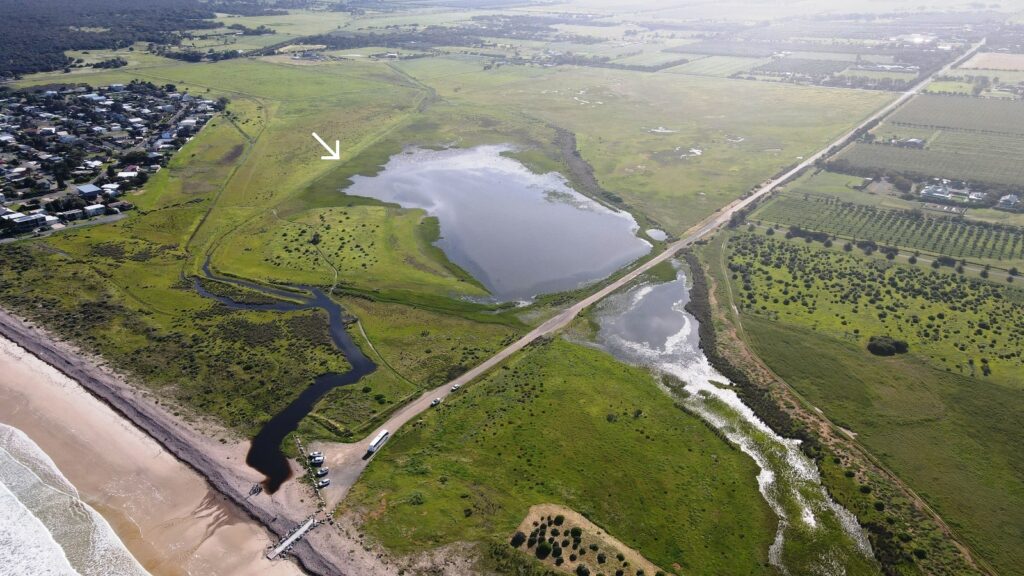Aldinga Washpool investigations will continue thanks to a Green Adelaide Grassroots Grant
NGT’s investigations into the potential for hydrological restoration of the Aldinga Washpool commenced in early 2021, thanks to a Green Adelaide Grassroots Grant. That grant culminated in our 2022 Ecohydrological Restoration Assessment Report, which outlines several options to restore the original shape, depth and general character of this highly significant wetland on the southern margin of metropolitan Adelaide. We are now pleased to announce that we have secured another Green Adelaide Grassroots Grant to continue our investigations into the Washpool for another two years!
This second grant is to implement the “High Priority Next Steps” identified in the 2022 Report. Specifically to:
- update Washpool catchment modelling to ensure future inflows will be sufficient to justify the increased volume of water that a restored Washpool would hold. We predict it would increase from 2.8 to 128 ML when full;
- determine accurately, and at a fine scale, the depth of sediment that has been deposited on the bed of the Washpool post-colonisation. This will provide guidance on the removal of this material to restore the original ‘floor’ (bathymetry) of the lagoon;
- assessment of the suitability of accumulated sediment within the Washpool for use as levee construction material. We proposed the construction of a levee to enable water levels in the Washpool to be restored without compromising stormwater drainage from Silver Sands housing estate. The use of material already within the Washpool would be more efficient, and presumably more culturally appropriate, than bringing in material from elsewhere to construct the levee;
- undertake an acid sulfate soil risk assessment of proposed excavation footprint, which is a standard requirement when undertaking earthworks in a saltmarsh environment such as the Washpool.
I also recently presented on the progress of the project, including our past and future Washpool investigations to the Friends of Willunga Basin at their AGM. At the meeting I reconnected with historian Tom Gara, who provided some great help with reference material for the 2022 report and who now lives in the area.
Subsequently, Tom has sent me several historical newspaper articles on the fascinating subject of pebble harvesting from Sellicks Beach. An example is provided below. Apparently, pebbles were harvested and sold for use in mining – placed into grinding mills presumably to help refine ore prior to smelting. They were also used in house construction for decorative purposes. Harvesting occurred for about 10 years between 1914 and 1924 and it appears that several thousand tonnes of pebbles were removed from the Sellicks Beach foredune. We cannot be certain but it is possible that the removal of pebbles near the mouth of the Washpool may have also contributed to the lowering of the sill of the lagoon, thereby contributing to the reduced depth and size of the water body.

Another interesting piece of the Washpool puzzle provided by Tom Gara was a photograph held in the State Library titled “The ‘Pebble King’ of Sellicks Beach” (see below).

This image, taken in 1920, shows of a group of men gathered around what is presumably a pile of sacks filled with pebbles harvested from the Sellicks Beach foredune. The group includes the Pebble King himself, Sinclair Heathersay, who is referred to in a number of newspaper articles from this period. Sitting atop the stack is Ted Button, likely a point of historic connection to contemporary Button Rd. In the front row, second from the left is Bob Herrick, the farmer who excavated a drain through the bed of the Washpool 30 years later in 1950. The legacy of Herrick’s drain is still clearly evident today in the form of the linear embankment that runs from the north-east to south-west through the Washpool (shown below).
It took us quite a bit of research to work out just what Mr. Herrick had done at the Washpool – it is covered in Chapter 4.2 of our 2022 Report – and it was a bit unexpected and exciting to see an image of the man himself! Thank you Tom for sharing your discoveries with us.


